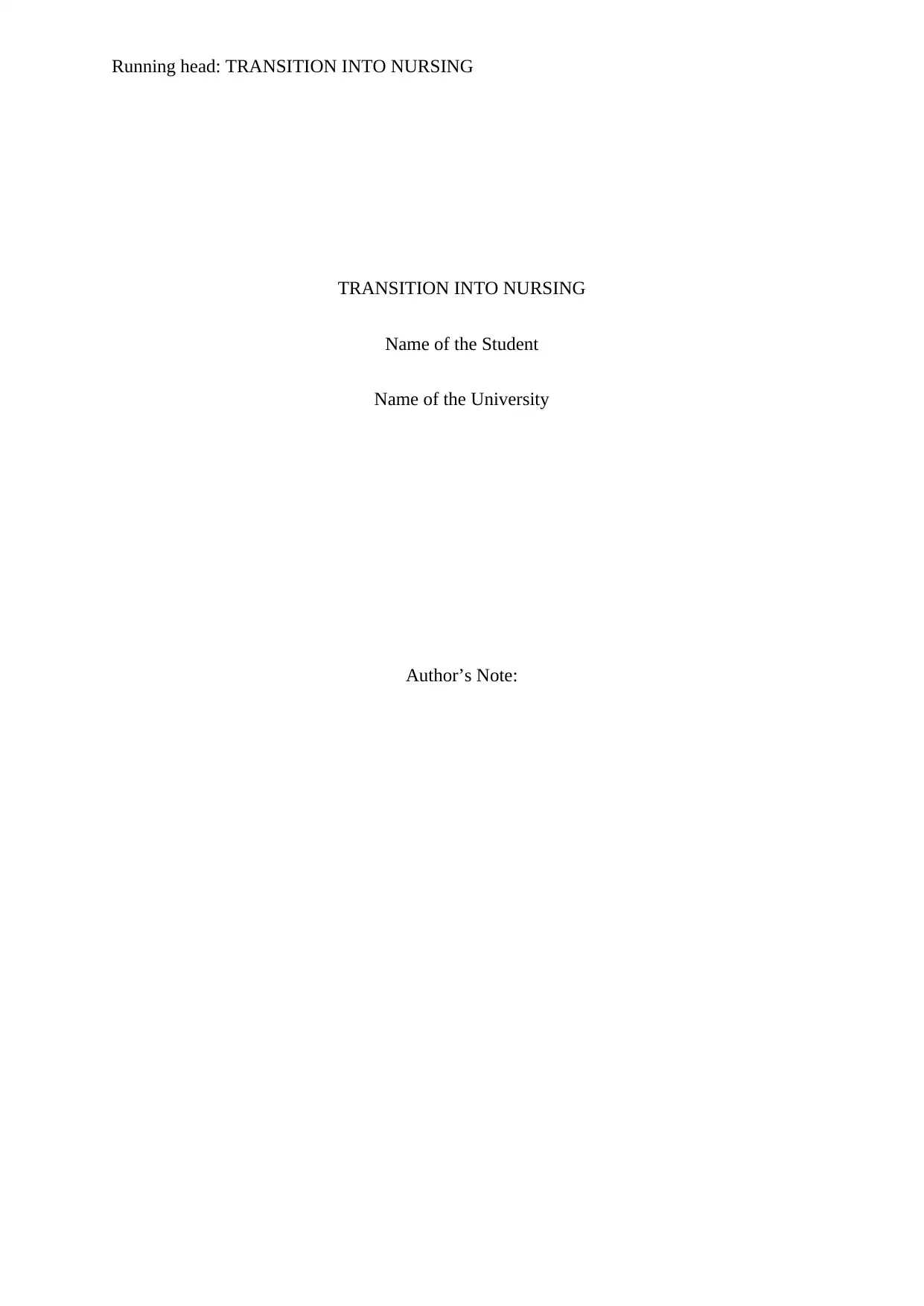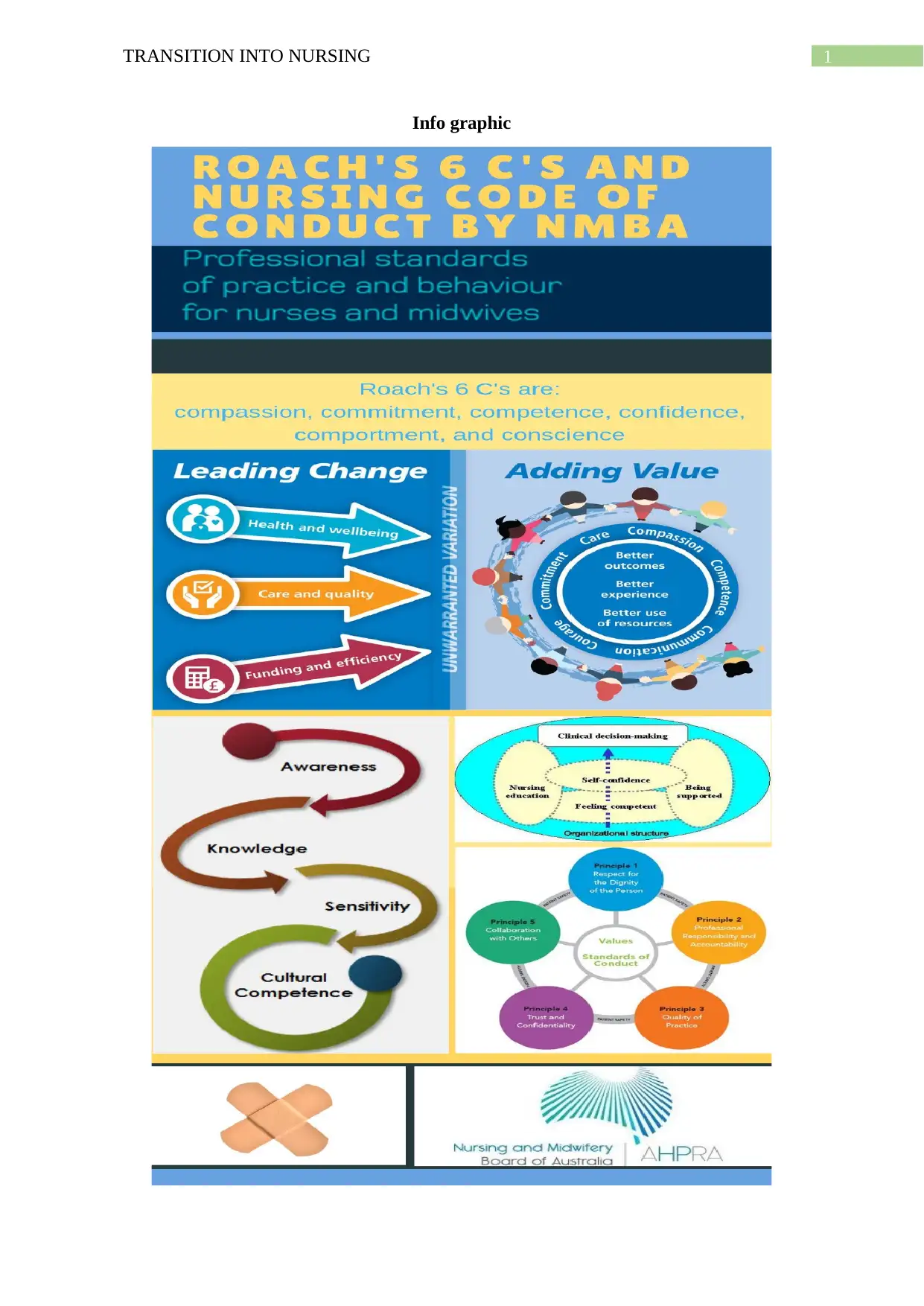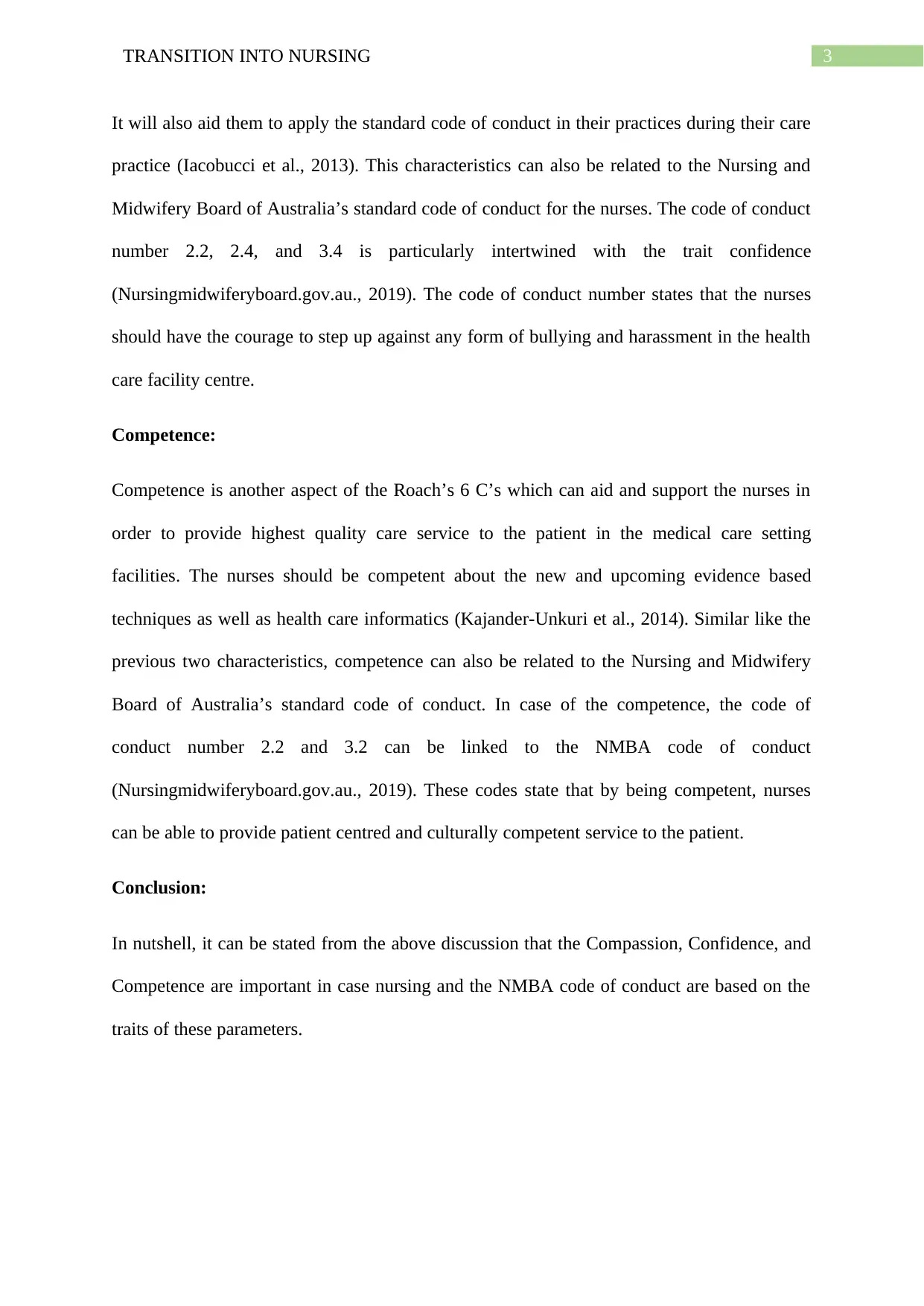Infographic & Rationale: 6 C's of Caring and NMBA Code of Conduct
VerifiedAdded on 2023/04/25
|5
|878
|490
Practical Assignment
AI Summary
This assignment is an infographic and a rationale that explores the relationships between the 6 C's of caring, as defined by Simon Roach, and the Nursing and Midwifery Board of Australia (NMBA) Code of Conduct. The student selected three of Roach's 6 C's—compassion, confidence, and competence—and visually represented how these elements connect to the NMBA Code of Conduct through an infographic. The rationale provides an 800-word explanation, analyzing how compassion, confidence, and competence align with specific codes within the NMBA's guidelines. The assignment highlights the importance of compassion, confidence, and competence in nursing practice, emphasizing their alignment with the ethical and professional standards expected of registered nurses, as outlined by the NMBA.

Running head: TRANSITION INTO NURSING
TRANSITION INTO NURSING
Name of the Student
Name of the University
Author’s Note:
TRANSITION INTO NURSING
Name of the Student
Name of the University
Author’s Note:
Paraphrase This Document
Need a fresh take? Get an instant paraphrase of this document with our AI Paraphraser

1TRANSITION INTO NURSING
Info graphic
Info graphic

2TRANSITION INTO NURSING
Rationale
Simon Roach has developed the 6 C’s of caring for nursing care which is inclusive of six
different aspects. These this 6 C’s are commitment, compassion, confidence, competence,
conscience, and comportment (Bradshaw, 2016). However, in this article only the
relationship between Compassion, Confidence, and Competence will be discussed.
Compassion:
Compassion is one of the primary aspect that a nursing professional should aware of while
care giving the patient. According to the academics, compassion is one of the basic human
value that helps the health professional to become considerate about the patient they are
caring. Hence, the concept of compassion should be included in the nursing study, so that the
nursing student develops a positive attitude during care delivery at the early stage of their
career. The best way to show compassion towards the patient through effective
communication (Wiklund Gustin & Wagner, 2013). The same has been mentioned in the
code of conduct for the nurse which is published by the Nursing and Midwifery Board of
Australia. In particular, the code of conduct number 3.2 and 3.3 are related to the compassion
(Nursingmidwiferyboard.gov.au., 2019). The code of conduct number 3.2 stated that a
nursing professional should be culturally competent in their practice and compassion can help
the nurses to provide culturally safe practice. On the other hand, the code of conduct number
3.3 mentioned that non- judgemental, clear and effective communication should be
maintained by the nurses during their care giving practice (Nursingmidwiferyboard.gov.au.,
2019).
Confidence:
In case of nursing profession, confidence plays a key role in their practice as it will help them
to overcome extreme conditions and they will be impose themselves in handling the situation.
Rationale
Simon Roach has developed the 6 C’s of caring for nursing care which is inclusive of six
different aspects. These this 6 C’s are commitment, compassion, confidence, competence,
conscience, and comportment (Bradshaw, 2016). However, in this article only the
relationship between Compassion, Confidence, and Competence will be discussed.
Compassion:
Compassion is one of the primary aspect that a nursing professional should aware of while
care giving the patient. According to the academics, compassion is one of the basic human
value that helps the health professional to become considerate about the patient they are
caring. Hence, the concept of compassion should be included in the nursing study, so that the
nursing student develops a positive attitude during care delivery at the early stage of their
career. The best way to show compassion towards the patient through effective
communication (Wiklund Gustin & Wagner, 2013). The same has been mentioned in the
code of conduct for the nurse which is published by the Nursing and Midwifery Board of
Australia. In particular, the code of conduct number 3.2 and 3.3 are related to the compassion
(Nursingmidwiferyboard.gov.au., 2019). The code of conduct number 3.2 stated that a
nursing professional should be culturally competent in their practice and compassion can help
the nurses to provide culturally safe practice. On the other hand, the code of conduct number
3.3 mentioned that non- judgemental, clear and effective communication should be
maintained by the nurses during their care giving practice (Nursingmidwiferyboard.gov.au.,
2019).
Confidence:
In case of nursing profession, confidence plays a key role in their practice as it will help them
to overcome extreme conditions and they will be impose themselves in handling the situation.
⊘ This is a preview!⊘
Do you want full access?
Subscribe today to unlock all pages.

Trusted by 1+ million students worldwide

3TRANSITION INTO NURSING
It will also aid them to apply the standard code of conduct in their practices during their care
practice (Iacobucci et al., 2013). This characteristics can also be related to the Nursing and
Midwifery Board of Australia’s standard code of conduct for the nurses. The code of conduct
number 2.2, 2.4, and 3.4 is particularly intertwined with the trait confidence
(Nursingmidwiferyboard.gov.au., 2019). The code of conduct number states that the nurses
should have the courage to step up against any form of bullying and harassment in the health
care facility centre.
Competence:
Competence is another aspect of the Roach’s 6 C’s which can aid and support the nurses in
order to provide highest quality care service to the patient in the medical care setting
facilities. The nurses should be competent about the new and upcoming evidence based
techniques as well as health care informatics (Kajander-Unkuri et al., 2014). Similar like the
previous two characteristics, competence can also be related to the Nursing and Midwifery
Board of Australia’s standard code of conduct. In case of the competence, the code of
conduct number 2.2 and 3.2 can be linked to the NMBA code of conduct
(Nursingmidwiferyboard.gov.au., 2019). These codes state that by being competent, nurses
can be able to provide patient centred and culturally competent service to the patient.
Conclusion:
In nutshell, it can be stated from the above discussion that the Compassion, Confidence, and
Competence are important in case nursing and the NMBA code of conduct are based on the
traits of these parameters.
It will also aid them to apply the standard code of conduct in their practices during their care
practice (Iacobucci et al., 2013). This characteristics can also be related to the Nursing and
Midwifery Board of Australia’s standard code of conduct for the nurses. The code of conduct
number 2.2, 2.4, and 3.4 is particularly intertwined with the trait confidence
(Nursingmidwiferyboard.gov.au., 2019). The code of conduct number states that the nurses
should have the courage to step up against any form of bullying and harassment in the health
care facility centre.
Competence:
Competence is another aspect of the Roach’s 6 C’s which can aid and support the nurses in
order to provide highest quality care service to the patient in the medical care setting
facilities. The nurses should be competent about the new and upcoming evidence based
techniques as well as health care informatics (Kajander-Unkuri et al., 2014). Similar like the
previous two characteristics, competence can also be related to the Nursing and Midwifery
Board of Australia’s standard code of conduct. In case of the competence, the code of
conduct number 2.2 and 3.2 can be linked to the NMBA code of conduct
(Nursingmidwiferyboard.gov.au., 2019). These codes state that by being competent, nurses
can be able to provide patient centred and culturally competent service to the patient.
Conclusion:
In nutshell, it can be stated from the above discussion that the Compassion, Confidence, and
Competence are important in case nursing and the NMBA code of conduct are based on the
traits of these parameters.
Paraphrase This Document
Need a fresh take? Get an instant paraphrase of this document with our AI Paraphraser

4TRANSITION INTO NURSING
References:
Bradshaw, A. (2016). An analysis of England's nursing policy on compassion and the 6 C s:
the hidden presence of M. Simone Roach's model of caring. Nursing inquiry, 23(1),
78-85.
Iacobucci, T. A., Daly, B. J., Lindell, D., & Griffin, M. Q. (2013). Professional values, self-
esteem, and ethical confidence of baccalaureate nursing students. Nursing
ethics, 20(4), 479-490.
Kajander-Unkuri, S., Meretoja, R., Katajisto, J., Saarikoski, M., Salminen, L., Suhonen, R., &
Leino-Kilpi, H. (2014). Self-assessed level of competence of graduating nursing
students and factors related to it. Nurse Education Today, 34(5), 795-801.
Nursingmidwiferyboard.gov.au. (2019). Nursing code of conducts. Retrieved from
http://www.nursingmidwiferyboard.gov.au/documents/default.aspx?
record=WD17%2F23850&dbid=AP&chksum=L8j874hp3DTlC1Sj4klHag%3D%3D
Wiklund Gustin, L., & Wagner, L. (2013). The butterfly effect of caring–clinical nursing
teachers’ understanding of self‐compassion as a source to compassionate
care. Scandinavian Journal of Caring Sciences, 27(1), 175-183.
References:
Bradshaw, A. (2016). An analysis of England's nursing policy on compassion and the 6 C s:
the hidden presence of M. Simone Roach's model of caring. Nursing inquiry, 23(1),
78-85.
Iacobucci, T. A., Daly, B. J., Lindell, D., & Griffin, M. Q. (2013). Professional values, self-
esteem, and ethical confidence of baccalaureate nursing students. Nursing
ethics, 20(4), 479-490.
Kajander-Unkuri, S., Meretoja, R., Katajisto, J., Saarikoski, M., Salminen, L., Suhonen, R., &
Leino-Kilpi, H. (2014). Self-assessed level of competence of graduating nursing
students and factors related to it. Nurse Education Today, 34(5), 795-801.
Nursingmidwiferyboard.gov.au. (2019). Nursing code of conducts. Retrieved from
http://www.nursingmidwiferyboard.gov.au/documents/default.aspx?
record=WD17%2F23850&dbid=AP&chksum=L8j874hp3DTlC1Sj4klHag%3D%3D
Wiklund Gustin, L., & Wagner, L. (2013). The butterfly effect of caring–clinical nursing
teachers’ understanding of self‐compassion as a source to compassionate
care. Scandinavian Journal of Caring Sciences, 27(1), 175-183.
1 out of 5
Related Documents
Your All-in-One AI-Powered Toolkit for Academic Success.
+13062052269
info@desklib.com
Available 24*7 on WhatsApp / Email
![[object Object]](/_next/static/media/star-bottom.7253800d.svg)
Unlock your academic potential
Copyright © 2020–2025 A2Z Services. All Rights Reserved. Developed and managed by ZUCOL.





